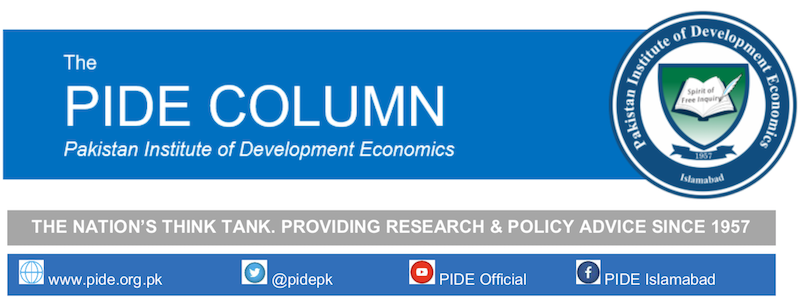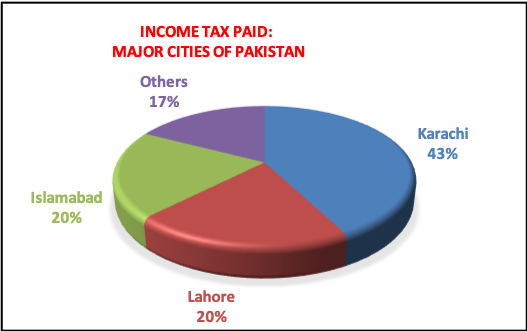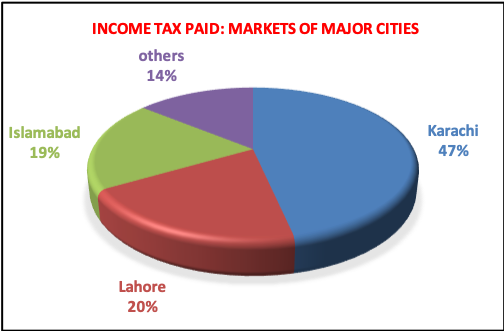
Idrees Khawaja and Ahmad Waqar Qasim review the tax directory recently published by Federal Board of Revenue (FBR) and present some startling data that should inform policy debate in Pakistan.
The FBR recently published a tax directory of income tax collected from parliamentarians, businesses, individuals, cities, and markets. The tax directory 2018 shows that income tax of Rs.1.03 trillion was collected from the major cities of Pakistan in 2017-18. Out of the Rs. 1.03 trillion collected from major cities, 80 percent came from three cities, namely Karachi, Lahore, and Islamabad. The directory also shows that the income tax of Rs. 210 billion was collected from major markets across the country in 2017-18. Of this amount, again, a large part (86 percent) was collected from the markets of the three cities, ie Karachi, Lahore and Islamabad.
 As income tax is paid against earned income, it is hard to miss an inference from the statistics just mentioned - economic activity occurs primarily in cities, rather in metropolises. One reason for the higher tax collection of the three cities is that the FBR shows the taxes paid by a company that operates in multiple cities, in the city where the company's head office is located. However, the very fact that companies prefer to locate their headquarters in Karachi, Lahore, or Islamabad has implications. On the other hand, the relatively lower tax collection from the markets of Faisalabad, Gujranwala, and Sialkot, despite its cluster reputation, also has implications that researchers should investigate.
As income tax is paid against earned income, it is hard to miss an inference from the statistics just mentioned - economic activity occurs primarily in cities, rather in metropolises. One reason for the higher tax collection of the three cities is that the FBR shows the taxes paid by a company that operates in multiple cities, in the city where the company's head office is located. However, the very fact that companies prefer to locate their headquarters in Karachi, Lahore, or Islamabad has implications. On the other hand, the relatively lower tax collection from the markets of Faisalabad, Gujranwala, and Sialkot, despite its cluster reputation, also has implications that researchers should investigate.
The markets of Karachi generated almost half of the income tax paid by Pakistan's major markets (Rs. 97 billion - 47 percent). This is despite the limitations of a poor law and order situation and not-so-good civic infrastructure that Karachi has faced for decades; imagine the trading volume and therefore the taxes, if the city is unconstrained. The markets of Lahore and Islamabad pay respectively 20.0% and 19.3% of the total tax collected from the major markets of Pakistan.
Karachi-Saddar alone generates an income tax of Rs. 77 billion - 79 percent of the total income tax paid by the markets of Karachi. Even more surprising is the fact that out of Rs. 40.5 billion paid by the markets of Islamabad Rs 39.9 billion (98.5 percent) is paid by the ‘Blue Area market’ alone. These figures give an idea: economic activity occurs in dense and easily accessible markets. Those familiar with these two cities also know that the two markets are easily accessible and dense.
 The tax directory also gives the number of filers in each market. The average income tax per filer or per entrepreneur in the markets of Karachi is Rs. 0.91 million, while the income tax paid per filer or entrepreneur in the markets of Islamabad is around Rs. 5.0 billion. If, whatever profit the income tax of Rs. 0.91 million reflects, is normal profit and is enough for an entrepreneur to survive in business then clearly the entrepreneurs of Islamabad are reaping excessive profit. Why aren't more entrepreneurs rushing to get a slice of the fairly large profits which entrepreneurs of Islamabad (especially those doing business in the "Blue Area") seem to enjoy? The answer could be hidden in Islamabad's limited retail space: Limited space has made property too expensive in the city. Expensive property represents a barrier to entry. Overcoming this barrier requires a significant capital investment.
The tax directory also gives the number of filers in each market. The average income tax per filer or per entrepreneur in the markets of Karachi is Rs. 0.91 million, while the income tax paid per filer or entrepreneur in the markets of Islamabad is around Rs. 5.0 billion. If, whatever profit the income tax of Rs. 0.91 million reflects, is normal profit and is enough for an entrepreneur to survive in business then clearly the entrepreneurs of Islamabad are reaping excessive profit. Why aren't more entrepreneurs rushing to get a slice of the fairly large profits which entrepreneurs of Islamabad (especially those doing business in the "Blue Area") seem to enjoy? The answer could be hidden in Islamabad's limited retail space: Limited space has made property too expensive in the city. Expensive property represents a barrier to entry. Overcoming this barrier requires a significant capital investment.
Peshawar’s Karkhano Market, which is the largest Bara market in the country, generates an income tax of Rs. 5.3 billion. Markets specifically named Bara markets in other cities collectively generate income taxes of Rs. 60 billion. The markets called landa bazzar and kabari market collectively generate Rs. 353 billion. The lesson from these figures is that the informal sector contributes to the economy, so let it exist.
Rawalpindi, which has a population of 5.41 million, its markets pay an income tax of Rs. 2.82 billion. On the other hand, Multan, with a lesser population of 4.75 million, its markets pay income taxes of Rs. 6.67 billion (Rs. 3.82 billion more than Rawalpindi). One explanation could be that Multan being the largest and most developed city in South Punjab, its residents mainly shop in Multan. On the other hand, residents of Rawalpindi and various other parts of the country appear to be shopping in Islamabad. These inferences carry worth pondering implications for city development.
 On corporate front, a total of 44,609 companies filed tax returns paying income tax of Rs. 497 million. 55% of companies paid no tax and 20% paid less than one lac Rupees as income tax. Out of over 44,000 thousand filers, 81% of the total income tax paid by the corporate sector came from just 600 companies. Top 5 tax-paying companies contributed Rs. 60 billion.
On corporate front, a total of 44,609 companies filed tax returns paying income tax of Rs. 497 million. 55% of companies paid no tax and 20% paid less than one lac Rupees as income tax. Out of over 44,000 thousand filers, 81% of the total income tax paid by the corporate sector came from just 600 companies. Top 5 tax-paying companies contributed Rs. 60 billion.
The 542 companies listed on stock exchange generated income tax of Rs. 198 billion - 98 pc of this came from 150 companies. Out of the 542 listed companies, 147 (27 pc) companies paid no tax. The textile sector with 153 listed companies is the largest sector in terms of number of companies. Ironically, the sector contributes only 3.2% of the total income tax collected on the stock market. The two sectors that pay the most income taxes are the financial sector (54.9 billion rupees) and oil and gas (46.2 billion rupees). Listed companies included in these two sectors collectively paid Rs 101 billion, which is 51 percent of the tax collected from the stock market.
Most (60 percent) of corporate income tax comes from unlisted companies, 27 percent of listed companies pay no tax, 98 percent of tax paid by listed companies comes from only a small fraction (28 percent) of companies and 51 percent of the tax paid by listed companies is contributed by only two sectors: financial and oil & gas; all of this unambiguously says one thing: Pakistan's stock market is very shallow.
The authors are researcher at PIDE. They can respectively be reached at: idreeskhawaja@pide.org.pk and ahmedwaqar@pide.org.pk
The FBR recently published a tax directory of income tax collected from parliamentarians, businesses, individuals, cities, and markets. The tax directory 2018 shows that income tax of Rs.1.03 trillion was collected from the major cities of Pakistan in 2017-18. Out of the Rs. 1.03 trillion collected from major cities, 80 percent came from three cities, namely Karachi, Lahore, and Islamabad. The directory also shows that the income tax of Rs. 210 billion was collected from major markets across the country in 2017-18. Of this amount, again, a large part (86 percent) was collected from the markets of the three cities, ie Karachi, Lahore and Islamabad.
 As income tax is paid against earned income, it is hard to miss an inference from the statistics just mentioned - economic activity occurs primarily in cities, rather in metropolises. One reason for the higher tax collection of the three cities is that the FBR shows the taxes paid by a company that operates in multiple cities, in the city where the company's head office is located. However, the very fact that companies prefer to locate their headquarters in Karachi, Lahore, or Islamabad has implications. On the other hand, the relatively lower tax collection from the markets of Faisalabad, Gujranwala, and Sialkot, despite its cluster reputation, also has implications that researchers should investigate.
As income tax is paid against earned income, it is hard to miss an inference from the statistics just mentioned - economic activity occurs primarily in cities, rather in metropolises. One reason for the higher tax collection of the three cities is that the FBR shows the taxes paid by a company that operates in multiple cities, in the city where the company's head office is located. However, the very fact that companies prefer to locate their headquarters in Karachi, Lahore, or Islamabad has implications. On the other hand, the relatively lower tax collection from the markets of Faisalabad, Gujranwala, and Sialkot, despite its cluster reputation, also has implications that researchers should investigate.The markets of Karachi generated almost half of the income tax paid by Pakistan's major markets (Rs. 97 billion - 47 percent). This is despite the limitations of a poor law and order situation and not-so-good civic infrastructure that Karachi has faced for decades; imagine the trading volume and therefore the taxes, if the city is unconstrained. The markets of Lahore and Islamabad pay respectively 20.0% and 19.3% of the total tax collected from the major markets of Pakistan.
Karachi-Saddar alone generates an income tax of Rs. 77 billion - 79 percent of the total income tax paid by the markets of Karachi. Even more surprising is the fact that out of Rs. 40.5 billion paid by the markets of Islamabad Rs 39.9 billion (98.5 percent) is paid by the ‘Blue Area market’ alone. These figures give an idea: economic activity occurs in dense and easily accessible markets. Those familiar with these two cities also know that the two markets are easily accessible and dense.
 The tax directory also gives the number of filers in each market. The average income tax per filer or per entrepreneur in the markets of Karachi is Rs. 0.91 million, while the income tax paid per filer or entrepreneur in the markets of Islamabad is around Rs. 5.0 billion. If, whatever profit the income tax of Rs. 0.91 million reflects, is normal profit and is enough for an entrepreneur to survive in business then clearly the entrepreneurs of Islamabad are reaping excessive profit. Why aren't more entrepreneurs rushing to get a slice of the fairly large profits which entrepreneurs of Islamabad (especially those doing business in the "Blue Area") seem to enjoy? The answer could be hidden in Islamabad's limited retail space: Limited space has made property too expensive in the city. Expensive property represents a barrier to entry. Overcoming this barrier requires a significant capital investment.
The tax directory also gives the number of filers in each market. The average income tax per filer or per entrepreneur in the markets of Karachi is Rs. 0.91 million, while the income tax paid per filer or entrepreneur in the markets of Islamabad is around Rs. 5.0 billion. If, whatever profit the income tax of Rs. 0.91 million reflects, is normal profit and is enough for an entrepreneur to survive in business then clearly the entrepreneurs of Islamabad are reaping excessive profit. Why aren't more entrepreneurs rushing to get a slice of the fairly large profits which entrepreneurs of Islamabad (especially those doing business in the "Blue Area") seem to enjoy? The answer could be hidden in Islamabad's limited retail space: Limited space has made property too expensive in the city. Expensive property represents a barrier to entry. Overcoming this barrier requires a significant capital investment.Peshawar’s Karkhano Market, which is the largest Bara market in the country, generates an income tax of Rs. 5.3 billion. Markets specifically named Bara markets in other cities collectively generate income taxes of Rs. 60 billion. The markets called landa bazzar and kabari market collectively generate Rs. 353 billion. The lesson from these figures is that the informal sector contributes to the economy, so let it exist.
Rawalpindi, which has a population of 5.41 million, its markets pay an income tax of Rs. 2.82 billion. On the other hand, Multan, with a lesser population of 4.75 million, its markets pay income taxes of Rs. 6.67 billion (Rs. 3.82 billion more than Rawalpindi). One explanation could be that Multan being the largest and most developed city in South Punjab, its residents mainly shop in Multan. On the other hand, residents of Rawalpindi and various other parts of the country appear to be shopping in Islamabad. These inferences carry worth pondering implications for city development.
 On corporate front, a total of 44,609 companies filed tax returns paying income tax of Rs. 497 million. 55% of companies paid no tax and 20% paid less than one lac Rupees as income tax. Out of over 44,000 thousand filers, 81% of the total income tax paid by the corporate sector came from just 600 companies. Top 5 tax-paying companies contributed Rs. 60 billion.
On corporate front, a total of 44,609 companies filed tax returns paying income tax of Rs. 497 million. 55% of companies paid no tax and 20% paid less than one lac Rupees as income tax. Out of over 44,000 thousand filers, 81% of the total income tax paid by the corporate sector came from just 600 companies. Top 5 tax-paying companies contributed Rs. 60 billion.The 542 companies listed on stock exchange generated income tax of Rs. 198 billion - 98 pc of this came from 150 companies. Out of the 542 listed companies, 147 (27 pc) companies paid no tax. The textile sector with 153 listed companies is the largest sector in terms of number of companies. Ironically, the sector contributes only 3.2% of the total income tax collected on the stock market. The two sectors that pay the most income taxes are the financial sector (54.9 billion rupees) and oil and gas (46.2 billion rupees). Listed companies included in these two sectors collectively paid Rs 101 billion, which is 51 percent of the tax collected from the stock market.
Most (60 percent) of corporate income tax comes from unlisted companies, 27 percent of listed companies pay no tax, 98 percent of tax paid by listed companies comes from only a small fraction (28 percent) of companies and 51 percent of the tax paid by listed companies is contributed by only two sectors: financial and oil & gas; all of this unambiguously says one thing: Pakistan's stock market is very shallow.
The authors are researcher at PIDE. They can respectively be reached at: idreeskhawaja@pide.org.pk and ahmedwaqar@pide.org.pk
